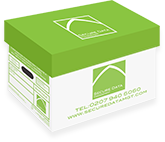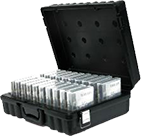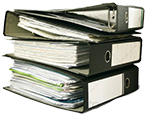Glossary Of Terms
Archiving
Archiving is the act of collecting and storing documents or data to preserve them. Your company should have an archiving method in place in order to keep control of paperwork and other materials.
Auditing
This is the process of checking all of your records for accuracy and ensuring you have all the correct documentation your business needs. Mostly applying to financial book-keeping, by performing an audit you are confirming that your accounts are fully examined and verified.
Barcoding
Once papers are collected into folders, bags or containers, these are labelled with a barcode for scanning by a reader device. The barcode is scanned when it is initially stored in a location, and then scanned again each time it moves. This creates an audit trail of its movements and any other changes. This is particularly useful not only for security reasons, but also for the quick retrieval of particular items.
Capture
When a document is brought into a management system; indexed, described and protected, this process is called capturing. It usually refers to the transformation of a physical record into a digital one using Capture software. By capturing your papers, your information is kept secure and stored in a manner that makes sense and best benefits your company.
Data Storage
This refers to the holding of data electronically. This is either via built in computer devices such as random access memory (RAM), or peripherals like hard disks, tapes and USB devices.
Destruction
If a document is no longer required to be retained in your records, it must be disposed of appropriately. A lot of paperwork will contain sensitive data such as figures or personal evidence, so it will need to be shredded. Your corporation should carry out regularly clear outs of unnecessary pieces. You can however outsource this crucial disposal to professionals.
Disaster Recovery
Otherwise known as DR, this refers to the policies and procedures that are essential should any form of disaster take place that would lead to the damage of the IT and technology equipment required to support the function of your business.
One of the solutions that many organisations adopt for recovery from disaster is backing up and store data off-site in a building that is specifically designed to combat or eradicate any risks.
Electronic Document Management (EDM)
This IT system uses computer software to manage electronic documents, with the ability to locate, move and retrieve information easily. Most EDM’s are also capable of keeping track of amendments and revisions to files modified by different users, giving you a full trace you can follow.
Fulfilment Services
If your business needs to deal with the picking, packing, storage and handling of stock, this can consume a lot of space and time. Services providing fulfilment can takeover by using their own warehouse space and staff to carry out these tasks for you. By outsourcing your fulfilment, you can instead focus on other key operations.
Imaging
Imaging is the process of scanning and replicating documents, storing them electronically so that you can reproduce them as and when they are needed. They are saved as images, but you can still conduct a full text search when looking for particular information. See Optical Character Recognition to find out how this is done.
Indexing
In order to make sure that a file is easily found on a management system, it must be indexed by assigning it with the right information in the right way.
This will usually include a reference to the original author, the title and the date when it was created. This data can be added manually, or extracted automatically by software.
OCR (Optical Character Recognition)
When paperwork is imaged and stored on the management system, it will be necessary to search for the vital information that you need. OCR encodes handwritten, typed or printed text into machine-friendly text so that its contents can be understood.
Online Archive Management
This is an incredibly secure online application that allows you to log in via a website and keep track of your off-site storage. You can view an inventory of your containers, as well as make retrieval requests, disposals and deliveries. Here at Secure Data Management, we use the renowned O’Neil System for all of our customers.
Perm Out Charges
A fee charged by document management providers for removing their boxes if you decide to no longer use their services. It is a necessity to bear this in mind when selecting, or switching providers.
Self-Storage
The rental of containers or other spaces within a warehouse to store items. These warehouses will have high security as well as measures put in place to avoid any natural or manmade disasters.
Records Management
The practice of controlling the life cycle of important records, from their original creation through to the disposal process. The process includes the storing, security, preservation, tracking and destroying of each individual record.
Records include any item that can be used as evidence of company activity, whether it is physical paperwork or electronic files such as word processor documents or even emails.
Retention Schedule
This is a catalogue of all records within your organisation and how long they should be kept for. Different types of records will have to be retained for varied periods of time. The retention periods chosen are based on legislation or regulations set both internally as well as by law.
Retrieval
Refers to the ability to find and retrieve files from a management system after searching for them using keywords and attributes defined during the indexing process, which is simplified by the implementation of optical character recognition for those that have been imaged.
Tape Rotation
A data tape or magnetic tape is a storage device which uses a strip of plastic which is covered with magnetic oxide. The tape has a series of parallel tracks where data can be recorded, stored and reused.
These tapes are barcoded for easy retrieval, meaning that they can be rotated and updated as often as you need. Time-sensitive and vital data should be rotated regularly, whereas less sensitive items can be rotated more sporadically.







